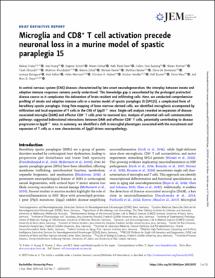Microglia and CD8+ T cell activation precede neuronal loss in a murine model of spastic paraplegia 15

Microglia and CD8+ T cell activation precede neuronal loss in a murine model of spastic paraplegia 15

| dc.contributor.author | Frolov, Aleksej | |
| dc.contributor.author | Huang, Hao | |
| dc.contributor.author | Schütz, Dagmar | |
| dc.contributor.author | Köhne, Maren | |
| dc.contributor.author | Blank-Stein, Nelli | |
| dc.contributor.author | Osei-Sarpong, Collins | |
| dc.contributor.author | Büttner, Maren | |
| dc.contributor.author | Elmzzahi, Tarek | |
| dc.contributor.author | Khundadze, Mukhran | |
| dc.contributor.author | Zahid, Marina | |
| dc.contributor.author | Reuter, Michael | |
| dc.contributor.author | Becker, Matthias | |
| dc.contributor.author | De Domenico, Elena | |
| dc.contributor.author | Bonaguro, Lorenzo | |
| dc.contributor.author | Kallies, Axel | |
| dc.contributor.author | Morrison, Helen | |
| dc.contributor.author | Hübner, Christian A. | |
| dc.contributor.author | Händler, Kristian | |
| dc.contributor.author | Stumm, Ralf | |
| dc.contributor.author | Mass, Elvira | |
| dc.contributor.author | Beyer, Marc D. | |
| dc.date.accessioned | 2025-10-30T13:30:16Z | |
| dc.date.available | 2025-10-30T13:30:16Z | |
| dc.date.issued | 23.04.2025 | |
| dc.identifier.uri | https://hdl.handle.net/20.500.11811/13610 | |
| dc.description.abstract | In central nervous system (CNS) diseases characterized by late-onset neurodegeneration, the interplay between innate and adaptive immune responses remains poorly understood. This knowledge gap is exacerbated by the prolonged protracted disease course as it complicates the delineation of brain-resident and infiltrating cells. Here, we conducted comprehensive profiling of innate and adaptive immune cells in a murine model of spastic paraplegia 15 (SPG15), a complicated form of hereditary spastic paraplegia. Using fate-mapping of bone marrow–derived cells, we identified microgliosis accompanied by infiltration and local expansion of T cells in the CNS of Spg15−/− mice. Single-cell analysis revealed an expansion of disease-associated microglia (DAM) and effector CD8+ T cells prior to neuronal loss. Analysis of potential cell–cell communication pathways suggested bidirectional interactions between DAM and effector CD8+ T cells, potentially contributing to disease progression in Spg15−/− mice. In summary, we identified a shift in microglial phenotypes associated with the recruitment and expansion of T cells as a new characteristic of Spg15-driven neuropathology. | en |
| dc.format.extent | 26 | |
| dc.language.iso | eng | |
| dc.rights | Namensnennung 4.0 International | |
| dc.rights.uri | http://creativecommons.org/licenses/by/4.0/ | |
| dc.subject.ddc | 610 Medizin, Gesundheit | |
| dc.title | Microglia and CD8+ T cell activation precede neuronal loss in a murine model of spastic paraplegia 15 | |
| dc.type | Wissenschaftlicher Artikel | |
| dc.publisher.name | Rockefeller University Press | |
| dc.publisher.location | New York, NY | |
| dc.rights.accessRights | openAccess | |
| dcterms.bibliographicCitation.volume | 2025, vol. 222 | |
| dcterms.bibliographicCitation.issue | iss. 7, e20232357 | |
| dcterms.bibliographicCitation.pagestart | 1 | |
| dcterms.bibliographicCitation.pageend | 21 | |
| dc.relation.doi | https://doi.org/10.1084/jem.20232357 | |
| dcterms.bibliographicCitation.journaltitle | Journal of experimental medicine | |
| ulbbn.pubtype | Zweitveröffentlichung | |
| dc.version | publishedVersion | |
| ulbbn.sponsorship.oaUnifund | OA-Förderung Universität Bonn |
Dateien zu dieser Ressource
Das Dokument erscheint in:
-
Publikationen (11)




